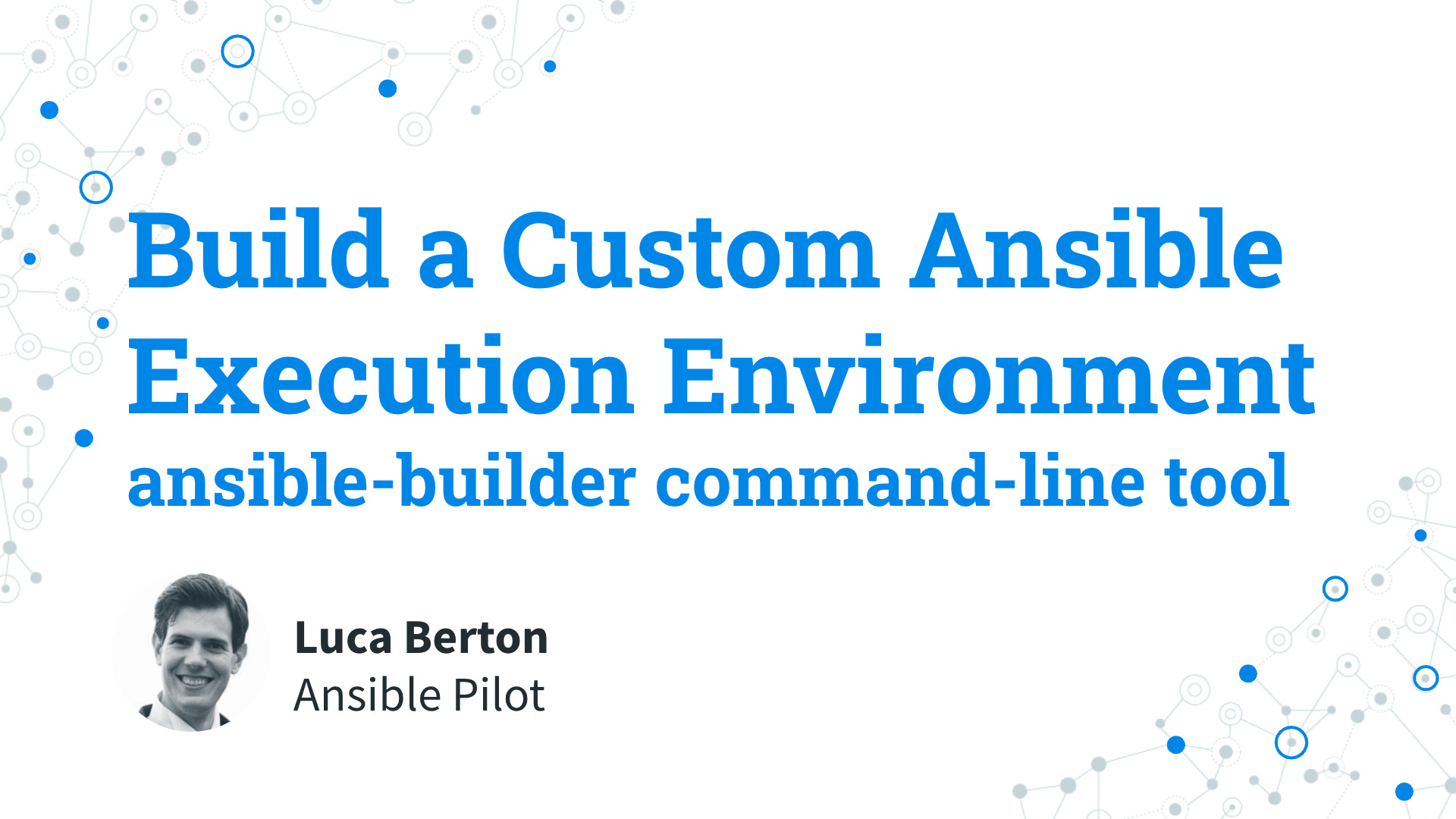How to build a custom Ansible Execution Environment?
Using an Ansible Execution Environment is the latest technology to maintain up-to-date Python dependency of the Ansible collections without interfering with your Linux system. It’s the evolution of Python Virtual Environment. This initial configuration sometimes is a roadblock for some Ansible users. I’m Luca Berton and welcome to today’s episode of Ansible Pilot.
Ansible Execution Environment
- Ansible Execution Environment
ansible-buildercommand-line toolansible-runnercommand-line tool
Let’s talk about the Ansible Execution Environment.
The Ansible Execution Environment is container images that can be utilized as Ansible control nodes.
It’s the latest technology developed by Red Hat to simplify the automation process.
The main advantage is a standard environment for Development and Production images using container technology creating portable automation runtimes.
This technology superseded manual Python Virtual Environments, Ansible module dependencies, and bubblewrap.
Experienced users are probably familiar with a lot of challenges managing custom Python Virtual Environments and Ansible module dependencies. Enterprise users of Ansible Automation Platform were familiar with limiting execution jobs under bubblewrap in order to isolate processes
The creation is performed by the Ansible Builder tool.
Ansible Builder produces a directory that acts as the build context for the container image build, containing the Containerfile, along with any other files that need to be added to the image.
On the other end, the execution is performed by the Ansible Runner tool.
The Ansible Runner enables you to run the Execution Environment as a container in the current machine. It is basically taking care that the content runs as expected.
Links
- https://www.ansible.com/products/execution-environments
- https://docs.ansible.com/automation-controller/latest/html/userguide/execution_environments.html

Playbook
Build an Ansible Execution Environment using ansible-builder tool
- Execution Environment name: my_ee
- System dependency: git
- Python dependency boto3
- Collection dependency: community.aws
How to Build an Ansible Execution Environment using ansible-builder tool.
I’m going to show you how to Build a custom “my_ee” Ansible Execution Environment using the ansible-builder tool specifying some custom System, Python, and collection dependency.
For example, let’s build a custom Ansible Execution Environment named “my_ee” With System requirements git, Python libraries boto3 and Amazon Collection community.aws.
code
- execution-environment.yml
---
version: 1
dependencies:
galaxy: requirements.yml
python: requirements.txt
system: bindep.txt
additional_build_steps:
prepend: |
RUN pip3 install --upgrade pip setuptools
append:
- RUN ls -al /
- requirements.yml
---
collections:
- name: community.aws
- requirements.txt
botocore>=1.18.0
boto3>=1.15.0
boto>=2.49.0
- bindep.txt
git [platform:rpm]
git [platform:dpkg]
execution
$ ansible-builder build -t my_ee -v 3
Running command:
podman build -f context/Containerfile -t my_ee context
Complete! The build context can be found at: /home/devops/ee/context
When the ansible-builder tool is not installed you should install it via DNF command using the ansible Automation Platform subscription:
[root@demo ee]# dnf install ansible-builder
The tool needs access to the Red Hat Container Registry available with your Red Hat Ansible Automation subscription (username and password of Red Hat Portal).
$ podman login registry.redhat.io
A successful build produces the following context/Containerfile:
ARG EE_BASE_IMAGE=registry.redhat.io/ansible-automation-platform-22/ee-minimal-rhel8:latest
ARG EE_BUILDER_IMAGE=registry.redhat.io/ansible-automation-platform-22/ansible-builder-rhel8:latest
FROM $EE_BASE_IMAGE as galaxy
ARG ANSIBLE_GALAXY_CLI_COLLECTION_OPTS=
USER root
ADD _build /build
WORKDIR /build
RUN ansible-galaxy role install -r requirements.yml --roles-path "/usr/share/ansible/roles"
RUN ANSIBLE_GALAXY_DISABLE_GPG_VERIFY=1 ansible-galaxy collection install $ANSIBLE_GALAXY_CLI_COLLECTION_OPTS -r requirements.yml --collections-path "/usr/share/ansible/collections"
FROM $EE_BUILDER_IMAGE as builder
COPY --from=galaxy /usr/share/ansible /usr/share/ansible
ADD _build/requirements.txt requirements.txt
ADD _build/bindep.txt bindep.txt
RUN ansible-builder introspect --sanitize --user-pip=requirements.txt --user-bindep=bindep.txt --write-bindep=/tmp/src/bindep.txt --write-pip=/tmp/src/requirements.txt
RUN assemble
FROM $EE_BASE_IMAGE
USER root
RUN pip3 install --upgrade pip setuptools
COPY --from=galaxy /usr/share/ansible /usr/share/ansible
COPY --from=builder /output/ /output/
RUN /output/install-from-bindep && rm -rf /output/wheels
RUN ls -la /
Conclusion
Now you know how to Build an Ansible Execution Environment using the ansible-builder command-line tool with custom System, Python and Ansible collection.
Academy
Learn the Ansible automation technology with some real-life examples in my
Udemy 300+ Lessons Video Course.

My book Ansible By Examples: 200+ Automation Examples For Linux and aws System Administrator and DevOps

Donate
Want to keep this project going? Please donate
